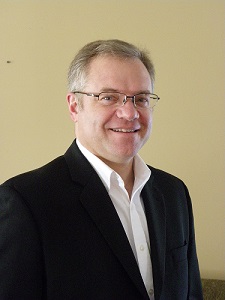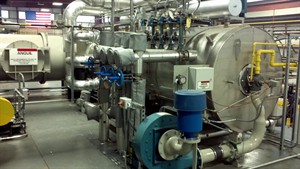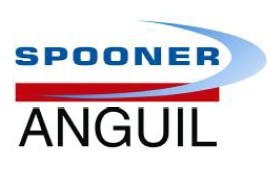New Senior Sales Manager Joins Anguil
Leave a Comment
Located in Milwaukee WI, Anguil designs, manufactures, installs and services thermal and catalytic oxidizers, vapor combustion technologies and energy recovery systems throughout the world. Jim’s sales and application knowledge will be used to apply Anguil’s equipment design into a variety of industries, from composites and printing, to chemical and packaging. The addition of Jim further enhances Anguil’s ability to efficiently and effectively reduce emissions and energy consumption at industrial facilities.
New Clean Air Techniques for Carbon Fiber Processes
Leave a Comment
When the first conversion plants came online, operating costs were not critical design parameters and neither were the environmental effects of production. Today, the manufacturing of carbon fiber is heavily regulated by the environmental community and producers are continually looking to reduce energy demands of this heat intensive process. The oxidation and carbonization furnaces and industrial ovens have the potential to emit hydrogen cyanide (HCN), ammonia (NH3) and volatile organic compounds (VOCs). Some of these pollutants are immediately dangerous to human health, even in very small quantities. Other pollutants of concern for carbon fiber producers include harmful gases such as carbon monoxide (CO) and nitrogen oxide (NOX). These emissions not only contribute to global warming but also have a direct correlation with the manufacturer’s consumption of energy.
Recycling at the Forefront
The strength, durability and light-weight characteristics of carbon fiber make it perfect for many manufactured products like airplanes and automobiles. However, most waste ends up in landfills where those same attributes do not allow the carbon fiber to break down like other organic material. A major university has opened a new, state of-the-art facility dedicated to the reuse of this valuable resource.
In conjunction with industry partners, they have developed a pilot scale carbon fiber recycling plant. The team set out to develop and commercialize recycled fiber that maintains the material strength at a cost-savings to manufacturers using carbon fiber in their products. The result was a lightweight, low cost material made from recycled carbon fiber that gives users a competitive advantage over virgin carbon fiber.
The university knew that an air pollution control device would be necessary to meet the local emission requirements for hydrogen cyanide (HCN) and ammonia (NH3). They also realized that there was the potential to reuse some of the energy released during the combustion of these carbon fiber processing emissions.
Anguil Environmental Systems (Anguil) was selected to provide the air pollution control system. Their experience with similar applications and ability to make a custom designed system to meet the unique needs of this pilot-scale recycling facility were the primary determining factors. Anguil manufactured, installed and recently brought online a Thermal Recuperative Oxidizer with dual heat recovery.
A metallic heat exchanger within the oxidizer reduces the amount of supplemental fuel required to bring the process emissions up to combustion temperatures. In addition, a secondary heat recovery system downstream of the oxidizer captures nearly all of the remaining heat for process heating needs. The extremely efficient system drastically reduces the operating costs of the carbon fiber manufacturing process. In addition, the Anguil oxidizer has been achieving over 99% destruction rate efficiency.
A Technology Transfer in the United States
Recognizing the need for this industry to develop a lower cost carbon fiber material, The United States Department of Energy built a custom designed conversion process at Oak Ridge National Laboratories (ORNL). The process equipment, designed by Harper International, makes this one of the most sophisticated and capable facilities in the industry. The carbon fiber technology line in Oakridge, Tennessee allows commercial partners to test the scalability of emerging carbon composite materials before commercial production.
To treat the exhaust streams coming from the carbon fiber process, Anguil Environmental Systems was commissioned to design, manufacture and install a multi-stage Direct Fired Thermal Oxidizer (DFTO). The abatement system is capable of destroying nitrogen compounds without the formation of NOX which is a typical by-product in conventional oxidation processes. Gases move through zones within the DFTO under varying conditions where the total emission destruction efficiencies are over 99% with minimal NOX generation.
Even though this application does not warrant additional NOX reduction, the Anguil DFTO has the capability of adding Selective Non-Catalytic Reduction (SCNR) to further reduce the environmental impact.
Anguil Environmental is a system provider of air pollution control and energy recovery solutions. We are intimately familiar with the capture, control and compliance hurdles of the carbon fiber industry. View our Carbon Fiber page for more information.
Home Market Foods Solves Odor Control Issues
Leave a CommentThe Norwood Bulletin recently highlighted the odor and pollution control efforts at Home Market Foods in Norwood, Massachusetts. Anguil is supplying a 30,000SCFM Regenerative Thermal Oxidizer (RTO) at this frozen food manufacturer to elimate emissions and odors. The Anguil RTO is an effective, efficient abatement device for many food processing applications.
We were pleased to be selected for this project and happy to help Home Market Foods with their environmental stewardship efforts. The full article can be found here.
Anguil Receives State & Regional Recognition from the SBA
Leave a CommentThe United States Small Business Administration (SBA) has announced the winner of its annual Jeffrey Butland award. Anguil is honored to be the 2013 recipient for both the state of Wisconsin as well as the Midwest region. The SBA acknowledges the contributions that small businesses make towards America’s economy by honoring the owners of these outstanding small businesses. The Jeffrey Butland award specifically highlights family owned and operated-small businesses that have transitioned to the second generation.
The news release for these SBA awards was published on Tuesday April 23rd 2013. Of the fifteen state winners, Anguil was one of four small business selected to receive regional recognition. Gene, Deb and Chris Anguil will be attending the 28th annual presentation breakfast on Friday May 31st at the Italian Community Center in Milwaukee, WI. An SBA Regional Administrator will be visiting Anguil Environmental in June to present the certificate for the company’s regional award.
Air Force Base Remediation Project Includes an Anguil Oxidizer
Leave a CommentKAFB Ramps Up Fuel Spill Cleanup
By John Fleck / Journal Staff Writer on Friday, January 18, 2013
A Kirtland Air Force Base crew is in the final stages of testing a new machine it hopes will accelerate cleanup of a fuel spill that has contaminated southeast Albuquerque groundwater.
On a concrete pad just north of the base flight line, workers Thursday were testing a garden-shed-sized furnace officials say will begin within the next week to burn off jet fuel sucked from deep under ground.
“It’s the next step in actually cleaning up the contaminants,” said Col. John Kubinec, the base commander.
Officials note that this is not the final remedy for the longstanding problem, but rather an interim measure to remove some fuel from the ground while the Air Force and state regulators wrestle with the long-term problem of cleaning up the decades-old mess.
“We wanted to get after this contamination sooner rather than later,” said John Kieling, head of the New Mexico Environment Department’s Hazardous Waste Bureau.
Contractors for the Air Force sank two wells six inches in diameter more than 500 feet into the ground adjacent to the base’s old fuel loading area, where in 1999 the Air Force discovered that an underground pipe had been leaking for decades.
Vacuum units will suck fuel vapors from the layers of soil above the groundwater, and the furnace unit will then burn it off, explained Brent Wilson, Kirtland’s civil engineer.
The fuel has moved through groundwater more than a mile from the spill site. None has been detected in Albuquerque drinking water wells. Test wells near Phil Chacon Park, between the nearest drinking water wells and the known fuel spill area, recently came back clean, suggesting the risk to drinking water is not imminent, according to the state Environment Department.
The Albuquerque Bernalillo County Water Utility Authority is in the midst of developing a network of early warning monitoring wells between the fuel spill and the nearest drinking water wells. The water utility is working with the U.S. Geological Survey to determine the best place to put the wells. The agency will pay for the wells but under an agreement with the Air Force, there is a possibility that the Air Force will reimburse the utility for the work, according to John Stomp, the utility’s chief operating officer.
Smaller “soil vapor extraction” units have been at work for years sucking aircraft fuel vapors from the ground, but the new larger system is designed to work more effectively at removing the fuel from the ground, Wilson said.
The cleanup efforts face challenges that officials at the Air Force and the state acknowledge cannot be solved with the systems currently in place. The biggest near-term issue is the fact that the water table in the area has been rising as a result of decreased drinking water pumping from nearby wells run by the water utility.
That rising water table has submerged a layer of jet fuel that had been resting in soil on top of the water table, making cleanup harder. In a December report to the Environment Department, the Air Force acknowledged that fuel layer, now trapped under water, “will be an ongoing source of dissolved groundwater contamination indefinitely.”
The Air Force and Environment Department are in talks about implementing the next cleanup step, which would begin removing some of that fuel submerged in the groundwater layer.
– This article appeared on page A1 of the Albuquerque Journal
New Service Resource for Oxidizer Operators
Leave a CommentOn a yearly average, Anguil services oxidizers made by dozens of different manufacturers. Put that knowledge to use for you by registering your oxidizer system(s) with Anguil and get a unique Service ID!
Participants in this program receive periodic maintenance recommendations, energy saving tips and service ideas for keeping your oxidizer running effectively and efficiently. In addition, your Anguil Service ID will streamline future service requests and scheduling.
As an added bonus you will immediately receive an Anguil hat, flash drive and pen! Future benefits may include complimentary operating cost evaluations and discounted service pricing.
Click Here for the Machine Registration Page
Beacon – Waste Gas Treatment Technologies for Carbon Fiber Processes
Leave a CommentIn conjunction with Harper International, Anguil Environmental announced the launch of Beacon™, a ground-breaking new program offering Carbon Fiber manufacturers the ability to evaluate the carbon footprint of their manufacturing process and identify opportunities for improvement.
With its extensive experience in the industry since the market’s inception, Harper has developed a model that analyzes various plant configurations and capacities, precursors, integration scenarios and energy recovery options and ranks the environmental impact of the process line. This endeavor establishes a baseline and a facility-specific metric that can be used to develop improvement plans to drive greater energy recovery and lower operating costs.
Anguil is excited to announce our participation in the Beacon as it pertains to the destruction of Hydrogen Cyanide (HCN), Ammonia (NH3), Silicone and Nitrous Oxide (NOX) emissions often produced in the ovens and furnaces of carbon fiber and composite plants. We design, manufacture, service and install energy-efficient oxidizer systems designed specifically for the air toxins that are often produced in the ovens and furnaces of carbon fiber manufacturers. Our company is intimately familiar with the capture, control and compliance hurdles that the processing plants face.
“The Carbon Fiber industry is at a critical maturity point where we must focus on achieving greatest output cost effectively with environmental responsibility in order to secure adoption in future market applications such as in automotive,” commented Robert Blackmon, VP of Integrated Systems at Harper.
The Beacon program is the only offering that comprehensively examines energy utilization in detail and develops solutions for improvement. We expect many to be inspired by this innovation, however Harper is clearly leading the way.”
A new website, harperbeacon.com , also launched as a part of the program. On this site, users can experience the concept of Beacon with a preview survey that evaluates the carbon footprint in a short example model. The complete Beacon model is a complex analysis of over a hundred design parameters. This work expands upon Harper’s previous cost modeling providing insight into the impact of energy efficiency as a part of the overall cost of operations.
Join Our Oxidizer Group on LinkedIn
Leave a CommentThe purpose of this subgroup is to specifically discuss the different oxidizer types, design criteria, performance data and service issues. The goal is to better educate oxidizer end users, consultants and engineering firms on the capabilities and best practices of these air pollution control devices.
New Partnership Spans the Ocean
Leave a Comment
Two capital equipment suppliers are announcing a partnership that will provide industrial facilities a single source solution for their dryer, oven and air pollution control needs. Anguil Environmental Systems, Inc., a United States based oxidizer manufacturer, and Spooner Industries, a convection dryer supplier located in the United Kingdom have partnered to better serve each of their respective markets and regions.
After working together on multiple turnkey projects, the two companies have decided to make their partnership official. Anguil Regenerative Thermal Oxidizers (RTOs), as well as Direct-Fired, Catalytic and Thermal Recuperative oxidizers are used for the destruction of Volatile Organic Compounds (VOCs), Hazardous Air Pollutants (HAPs), NOX and odorous air emissions often generated from the drying and curing equipment manufactured by Spooner. By combining the complimentary product lines, customers and prospects can get a complete turnkey solution for their industrial drying, curing, coating and air pollution control needs. In addition, the Anguil Heat and Energy Recovery products can be applied on these industrial systems to reduce operating costs and energy consumption.
Under the new agreement, Spooner Industries will fabricate and install the Anguil oxidizer designs on air pollution control applications throughout Europe. They will work exclusively together for the supply of oxidizers for European converting, coating and printing operations. The systems will incorporate the established, proven designs of Anguil Environmental and the quality, dependable fabrication of Spooner Industries. Spooner’s new 60,000 square foot facility will be the primary manufacturing location for Anguil oxidizer systems going into Eastern and Western Europe. The local UK fabrication capability will allow Anguil to serve the European region without expensive transportation costs.
In the United States and North America, existing Spooner customers will now have the assurance of working with a dryer company that has local air pollution control and energy recovery capabilities. Anguil’s extensive service capabilities will also be utilized in America for Spooner customers with emergency or long-term service needs. In addition, Anguil customers with dryer and coating systems will have the experience of Spooner’s technologies through Anguil.
Both Spooner and Anguil are long standing companies with excellent reputations, having been in business since 1932 and 1978, respectively. “We are extremely excited about this new partnership” says Gene Anguil, CEO of Anguil “Not only are our product offerings complimentary but our firms have a similar philosophy and focus with custom engineered industrial systems”. Steve Newell, Sales & Marketing Director at Spooner Industries agrees “This partnership with Anguil fits extremely well with Spooner in terms of technology, markets and culture. The disciplines involved with these units are very similar to our core competence”
For more information visit www.spooner-environment.com
Anguil Named the Midwest’s Exporter of the Year!
Leave a CommentAnguil is Honored for Export Excellence by the SBA for both the State of Wisconsin and Midwest Region.
Anguil Environmental Systems Inc. has been honored for the second year in a row with the 2007 Small Industrial Exporter Award for the state of Wisconsin. Anguil was one of nine Wisconsin companies that received the Governor’s Export Achievement Award from the offices of Governor Jim Doyle.
The Small Business Administration also recognized the company with a Regional award for Industrial Exporter of 2007 and Anguil is now being considered on the National level.
The Wisconsin International Trade Conference is the largest gathering of international trade professionals in the state. The award criteria included the degree of export-related growth; innovative techniques and approaches that resulted in the company’s success; and demonstration of extra effort in capturing worldwide markets. Anguil is extremely honored to receive the acknowledgement in the Small Industrial Exporter Category and expects to see continued success overseas in the upcoming years.
“Wisconsin exports have shown four straight years of incredibly strong growth, and our growth continues to surpass that of the nation,” Doyle said in a statement.
